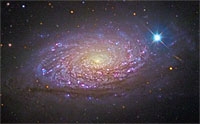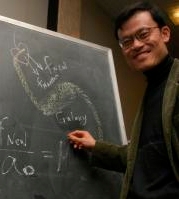
New light on dark matter
An international team of astronomers has found an unexpected link between dark matter and visible stars in stellar systems. This discovery may even cause us to reconsider our understanding of gravity. They published on their discovery in 'Nature' on 1 October.

Gravity
The material in stellar systems is held together by gravity. The stars in stellar systems travel so fast that extra force is needed to keep them together. The researchers believe this force is provided by the gravity of a halo of invisible dark matter. This dark matter exercises so much force that it even dominates the total mass of stellar systems.
Interaction
Researchers assume that dark matter exercises influence on the normal matter of which we consist, only through gravity. But the new observations indicate that the interaction between dark and normal matter is much more complex. Dark matter seems to 'know' how the visible material is distributed. Dark and visible matter seem to work together such that the average gravity of the visible material within a characteristic beam of the dark halo is always the same.
Invisible hand
‘The pattern we have discovered is very strange; rather like discovering in a zoo that animals of different species all have an equally heavy skull,' explains Dr Hongsheng Zhao, visiting researcher at Leiden University. 'It is feasible that an unknown new force might influence dark material, like an invisible hand, leaving behind the same fingerprints on all stellar systems. Such a force could even explain the enigma of dark energy, that dominates the expansion of the universe.'
More radical solution

‘A more radical solution would be to adjust the laws of gravity such that the existence of dark matter would be merely a pretence, a consequence of a deviation in the laws of gravity as discovered by Newton and Einstein. But such theories have their own problems on a cosmic scale,' adds Dr Benoit Famaey, of the Universities of Bonn and Strasburg. Dr Gianfranco Gentile, of the Universities of Ghent and Brussels and head of the collaboration, concludes: 'Resolving this enigma is probably one of the keys to understanding the origin, the evolution and the structure of stellar systems in the history of our cosmos.'
Zhao's research in Leiden is supported by subsidies from the Netherlands Organisation for Scientific Research and the Foundation for Fundamental Research on Matter.
